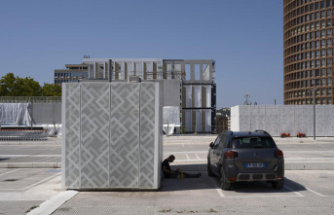An “exceptional” quantity of dust from the Sahara has been crossing Western Europe from south to north since Saturday, with harmful consequences on air quality, the European Copernicus Observatory warned on Monday April 8. .
This phenomenon, the third in two weeks, of “large-scale transport of Saharan dust across Europe” led to “high concentrations of PM10” (particles with a diameter of less than 10 micrometers) “in the Iberian Peninsula as well as in parts of France and Germany,” sometimes exceeding the European daily normal, according to the Copernicus Air Quality Monitoring Service (CAMS).
“Daily maximum CAMS forecast values for PM10 showed significant concentrations at surface level, exceeding the European Union twenty-four-hour average exposure threshold of 50 micrograms per cubic meter (µg/m3) in some of the affected regions,” Copernicus said in a statement.
These concentrations will continue to increase in the coming days thanks to atmospheric circulations which prolong this transport, warns CAMS.
The dust plume has already crossed most of the Iberian Peninsula, reaching southeastern France and Germany, as far as Scandinavia.
Asthma attacks or allergies
“This latest episode of Saharan dust is the third of its kind in the last two weeks and is linked to weather conditions which have led to warmer weather across Western Europe in recent days,” said Mark Parrington, a senior scientist. of CAMS. “Although it is not uncommon for plumes of Saharan dust to reach Europe, the intensity and frequency of such episodes have increased in recent years, which could potentially be attributed to changes in circulation patterns atmospheric,” he adds.
In France on Sunday, the regional air quality observatory Atmo Occitanie had warned of degraded air quality, with five departments – Haute-Garonne, Gers, Ariège, Pyrénées-Orientales, Hautes-Pyrénées – in level 4 (bad), on a scale from 1 (good) to 6 (extremely bad).
Exposure to high levels of PM10 can have various effects on health, including triggering asthma attacks or allergies and aggravating certain respiratory or cardiovascular pathologies, particularly in vulnerable people (pregnant women, children, people elderly or immunocompromised).
The Sahara is the largest source of mineral dust. It releases between 60 and 200 million tonnes per year. While larger particles fall quickly to the ground, smaller particles can be transported thousands of kilometers.












